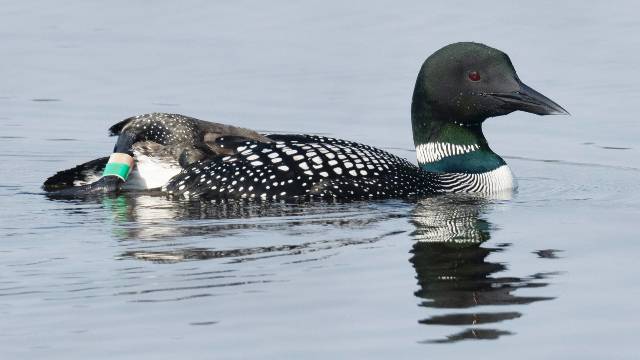By Carol Stiffler
ABJ is back, and better than expected. Much better.
The world’s oldest known male loon, ABJ, was located last week by Louis Good, a student at Northern Michigan University.
Good found the bird on a spontaneous, first-ever trip on the Seney Wildlife Refuge’s Marshland Wildlife Drive. He was traveling with his parents and had been hesitant to take the scenic drive. He’d just finished a 30-day internship on Isle Royale, where he joined a group studying the wolf-moose balance on the island. He saw loads of wildlife there.
“I thought, ‘What else am I going to actually see?’” said Good, who lives in lower Michigan.
He saw trumpeter swans, muskrats, some Canada geese, and only two loons. But they were perhaps the most surprising loons.
They were on E Pool, and pretty close to Good, who is studying fisheries and wildlife at NMU, with a focus on wildlife. He took a few photos. In at least one picture, a loon’s identification bands were showing.
When Good zoomed in on the photo, he saw the loon had a broken bill.
“I kind of made a judgment,” said Good, “that a broken bill means old age.” That rang a bell, and his internet research brought up the story of ABJ, the world’s oldest known male loon, who’d recently broken his bill in an assumed fight for territory. ABJ disappeared soon after losing that fight, and his fans–who span the globe–worried.
On his first-ever trip through the refuge, Good had discovered ABJ–alive and well.
“I got super excited,” Good said. “The bird is older than me. It’s pretty insane that they live that long.”
Damon McCormick, co-founder of Common Coast Research and Conservation, reviewed Good’s photos and confirmed it is indeed ABJ. After a few days of research by refuge staff, ABJ’s story grew even more interesting: He has a new girlfriend.
ABJ and his new partner, a yet unidentified female loon, are nesting in a remote spot on E Pool.
McCormick said the situation is practically miraculous.
“It’s kind of a stunner,” he said.
It may take time to learn the identity of ABJ’s new mate, though it’s certainly not Fe, his previous and long-term partner. McCormick said it’ll take time and patience to get a good photo of the female’s legs to look for identification bands, if she has any. Refuge visitors who snap photos of loons with leg bands may be able to help solve the mystery.
As for Good, he’ll head back to NMU this fall as a senior, finishing his studies in fisheries and wildlife management. His focus is on wildlife, with a particular interest in loons and large mammals. He’s fascinated by loon migration – traveling thousands of miles and returning to precisely the same body of water. And now he’ll forever be associated with one of the most famous loons in the world.
“That’s pretty much my story,” Good said. “I’ve been wanting to drive that [Marshland Wildlife Drive] and finally got the chance, and just got lucky.”












